Are you looking for Monstera plant species to buy, but you don’t know which ones? You are on the right page. We will look at the 14 stunning Monstera plant species, including their variegated forms, including an image. It should be easier to decide on which species suits you.
We will also talk about general care. But we don’t intend to go into Monstera plant care or detail on each species as we have covered them elsewhere.
Contents
- About Monstera plant
- Best Monstera plant species
- 1. Monstera deliciosa
- a. Non-variegated M. deliciosa
- b. Variegated M. deliciosa
- 2. Monstera adansonii
- a. non-variegated
- b. Variegated
- 3. Monstera standleyana (green form, albo variegata, and aurea)
- 4. Monstera dubia
- 5. Monstera obliqua
- 6. Monstera Peru (Monstera karstenianum)
- 7. Monstera lechleriana
- 8. Monstera pinnatipartita
- 9. Monstera acuminata
- 10. Monstera subpinnata
- 11. Monstera acacoyaguensis
- 12. Monstera epipremnoides
- 13. Monstera Spruceana
- 14. Monstera dissecta
- Monstera plant care
- Monstera plant pests, diseases, and common issues
- FAQs
About Monstera plant
Monstera is a genus with over 45 plant tropical climbing species native to tropical America and surrounding islands. Some of these species make lovely, air-purifying houseplants in North America. But they are also popular in other places, including Europe, Australia, Asia, etc.

The term Monstera is Latin, and it means monstrous or abnormal, referring to the leaves that develop fenestrations or holes. Remember, foliage is the main reason why people have these plants.
These tropical rainforest climbing plants grow as hemiepiphytes, i.e., have a terrestrial (ground) stage and epiphyte (growing on hosts) growth phase. You will find them growing beneath the canopies of tall rainforest trees in the wild.
Last but not least, this plant belongs to the family Araceae (aroids) that has many other lovely houseplants.
Warning:
All Monstera plant species are toxic to humans, dogs, cats, and other pets because they have insoluble calcium oxalate. Chewing them will cause severe oral irritation, burning feeling, swelling, drooling, swelling difficulties, loss of appetite, etc.
Best Monstera plant species
If you have decided to buy these plants, you can go for the variegated Monstera and non-variegated ones.
Common variegated plants include Monstera albo (white), aurea (yellow), and mint variegata. Some variegated species may have half-moon leaves, others streaks, sectors, speckles, splashes, or marbling.
Here are the most ones to go for:
1. Monstera deliciosa
The adorable, heart-shaped, deep green glossy leaves that get splits and holes (fenestration) make Monstera deliciosa the most popular species. Its common names are Swiss cheese plant, split-leaf philodendron, Mexican fruit bread, or ceriman) and it is the only one with edible fruits once they fully ripen.
You can go for the various varieties or buy variegated forms. Both make lovely plants, but the latter will cost more.
a. Non-variegated M. deliciosa
Besides the main M. deliciosa, you can go for the various varieties, including M. deliciosa var. borsigiana, var. sierrana, var. Brazil or var. Tauerii. The common one is var. borsigiana.
There isn’t much difference between M. deliciosa and M. deliciosa var. borsigiana. The former is a stout plant that sprawls over a larger area, and the latter grows more like a vine.
That is not all. Var. borsigiana plant has smaller leaves that are evenly pinnatifid (split) and don’t have a wrinkled geniculum. Also, the internodes are longer, and the vines are thinner.
The average price of green Monstera deliciosa is $10 to $50, with var. borsigiana slightly cheaper. But var. Brazil and var. Sierrana plants are rare and expensive, going for between $200 to $3000 or more.
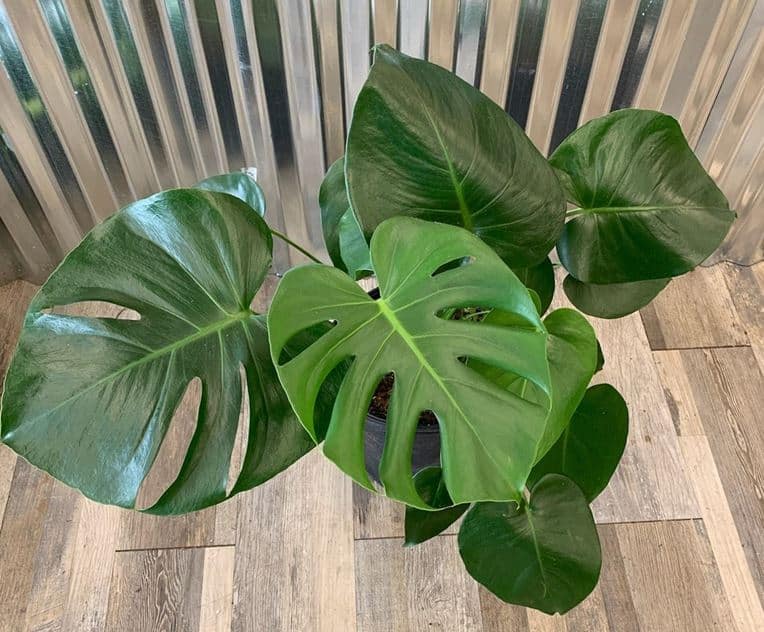
b. Variegated M. deliciosa
Variegated forms will completely transform your space, adding a tropical charm and colorful vibe. They look alluring, and you are free to go for the aurea, mint, or albo variegata. There is also the Thai constellation which looks stunning.
Made in a lab in Thailand, the Thai Constellation is the most adorable Monstera delicious variegated plant. It has charming cream to white scattered splashes, speckles, and sectors resembling a constellation in the sky.
It is stable (unlikely to revert), but each leaf looks unique. The Thai constellation will cost between $150 to $1000. But if you are willing to wait until 2023, Costa Farms’ Trending Tropicals® Collection features them. The price will drastically drop.

Monstera albo borsigiana (M. deliciosa var. borsigiana albo variegata) has deep green leaves with white to cream streaks, marbling, or sectors with some plants having half-moon white variegated leaves.
Like most other variegated Monstera plants, the markings are unstable (may revert or go completely white). If you need it, it costs $170 to $1200.
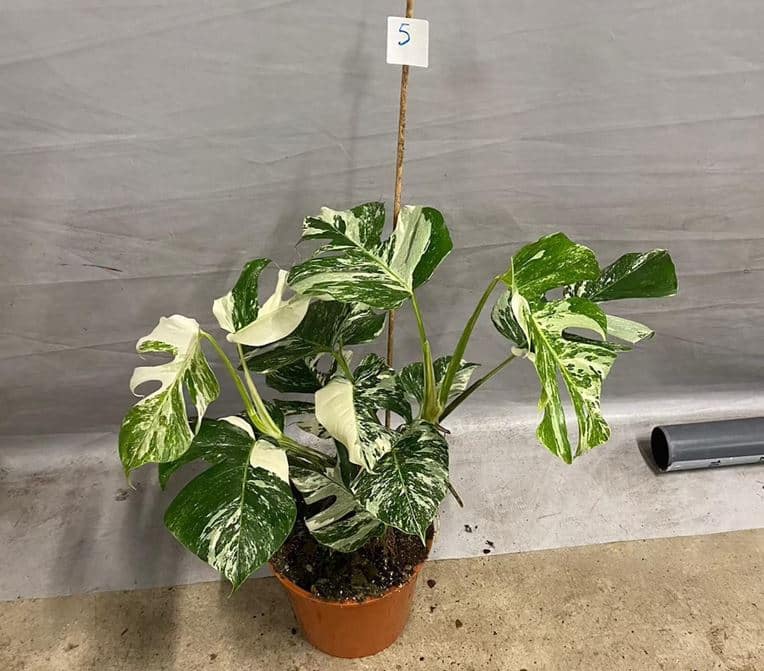
Monstera deliciosa aurea (marmorata) is another impressive variegated form that you will love. It has yellowish blotches, marbling, speckles, streaks, splashes, or sectors, including half-moon on its glossy green leaves. If you want to buy this charming plant, you must be willing to spend $600 to $4000.

The last option is Monstera deliciosa mint, whose glossy deep green leaves have mint (vibrant light green) variegation. Some vendors also have green on green variegated plants. Would you like to have this mint variegated plant? You must be ready to spend a fortune as it costs between $3500 and $16000.
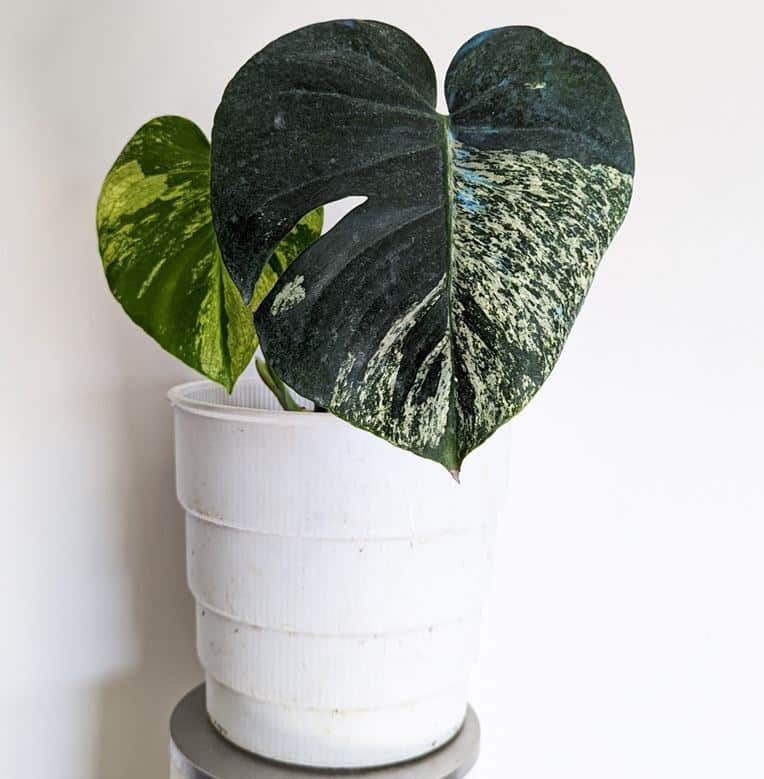
2. Monstera adansonii
Monstera adansonii (Swiss cheese plant, five-hole plant, Cheese Swiss philodendron, or Monkey Mask monstera) is superb and trendy. It has oval to elliptical glossy green leaves that get holes early. But their margin remains entire.
As a complex species, you will find forms, i.e., the narrow and wide form, varieties, and variegated forms.
a. non-variegated
The non-variegated Monstera adansonii (narrow or wide) price ranges from $10 for a cutting to about $50 for an established plant. You can buy the wide, narrow or Monstera adansonii var. laniata (M. friedrichsthalii).
The wide form is what many people sell as M. adansonii. It has ruffled, broader leaves that appear almost symmetrical. Also, the holes are more and are a bit roundish, i.e., not so elliptical.

On the other hand, the narrow form has slender, elongated, and unequal leaves with the lamina length, more than twice the width. It has fewer elliptical holes than the wide form and a smooth surface.
M. adansonii Swiss Cheese Plant Narrow form:
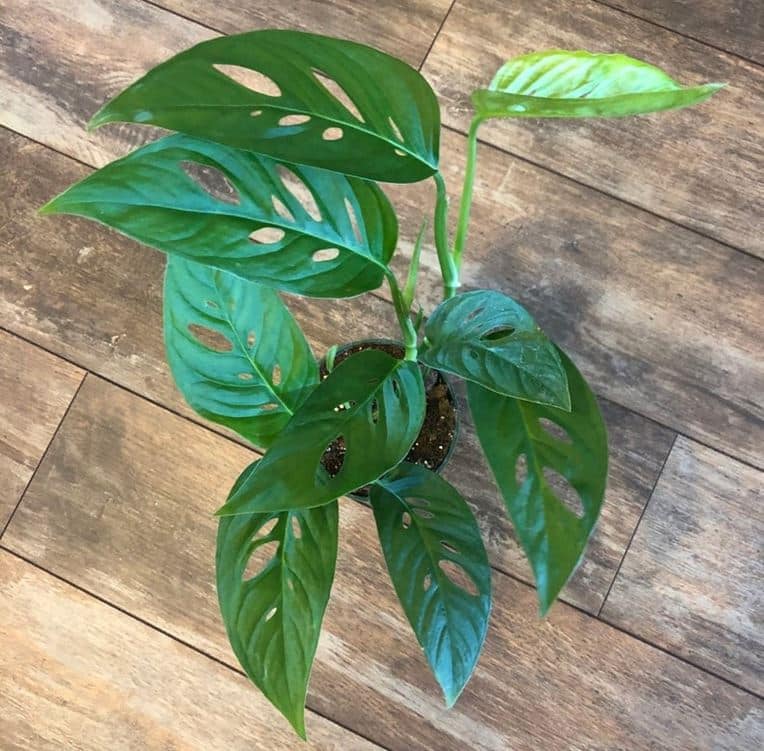
b. Variegated
If you prefer variegated Monstera adansonii, the albo variegata is a perfect pick. Its green leaves have cream to white variegation. Common ones are the M. adansonii archipelago, Albo Japanese Tricolor, and half-moon leaf.
As a rare plant, you expect to spend more. The price range is between $250 to $2500.

The other option you can go for is the aurea or yellow variegated plant, which will cost you between 250 to $3000. You will love the yellowish streaks and marbling, with some having half-moon leaves.
M. adansonii aurea:

Lastly, if you still want a variegated Swiss cheese plant, we recommend considering the Monstera adansonii mint with vibrant green variegation. The average price for this mint variegated plant is $150 to $400.
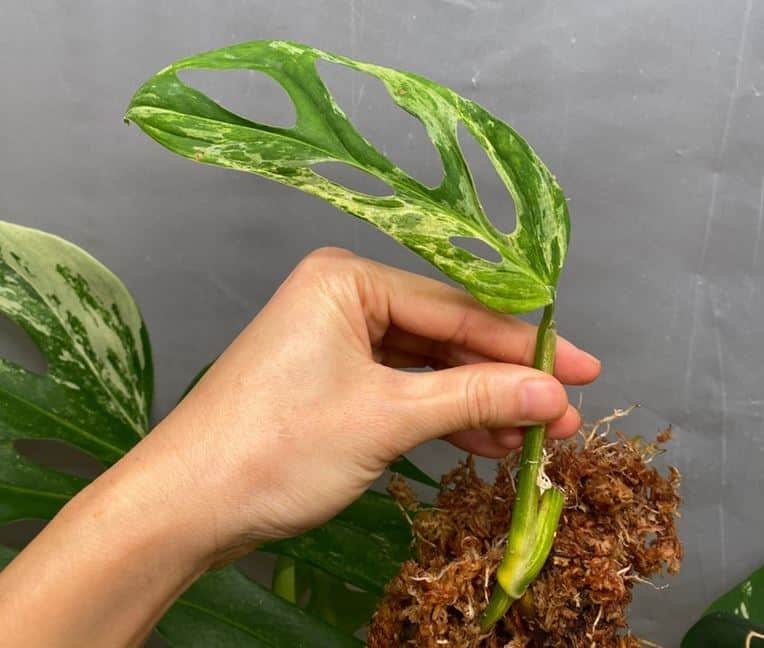
3. Monstera standleyana (green form, albo variegata, and aurea)
The oval to elliptical lovely glossy deep green leaves make Monstera standleyana or Philodendron Cobra a great pick. It will have large leaves that don’t split and rarely have holes when it matures.
This non-variegated form, often referred to as the green form, will cost you $15 and $50. It’s not so popular or common.
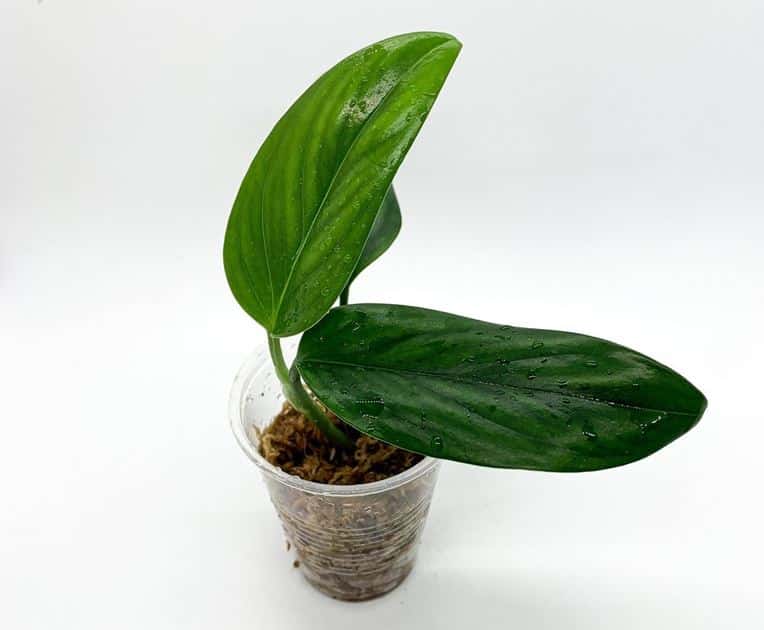
If you want something a little more colorful, you can go for Monstera standleyana albo variegata with cream to white splashes, speckles, bands, including Halfmoon sectors. It will cost you $25 to $100, making it an affordable buy.
M. standleyana albo variegata:
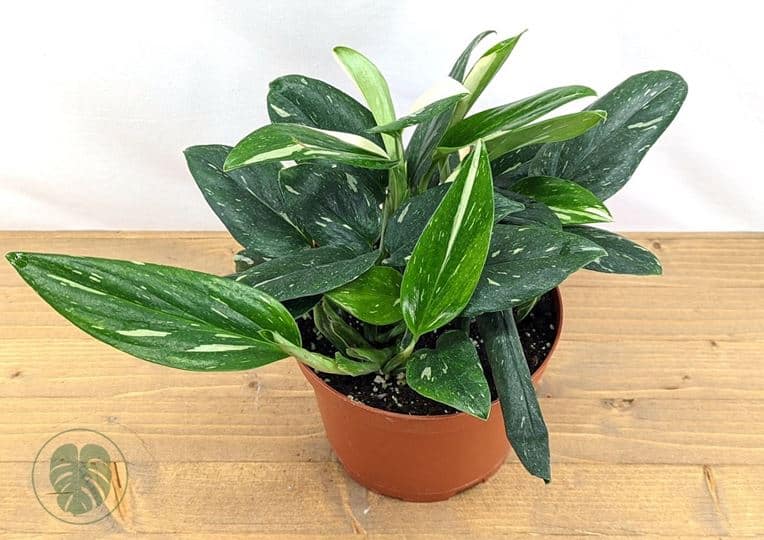
Monstera standleyana aurea, or the yellow variegated form, is the other lovely plant with the same deep green leaves but with yellow markings – streaks, marbling, half-moon, etc. It goes for only $100 to $300. We bet you will love it.
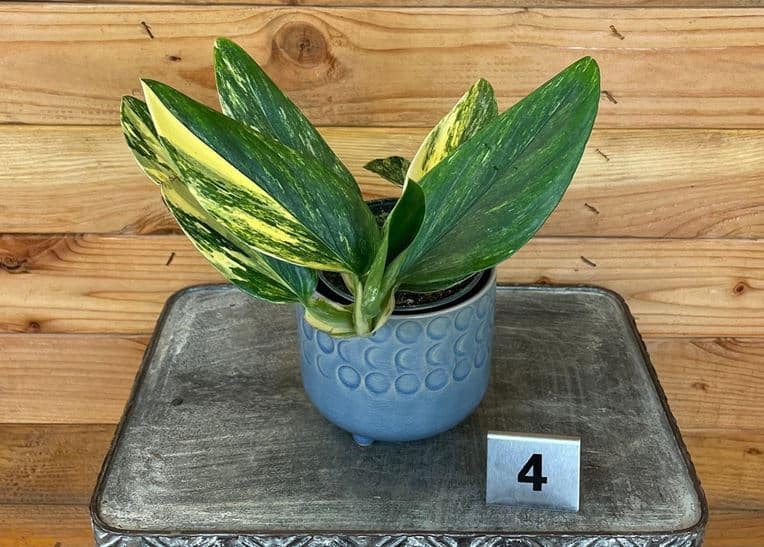
4. Monstera dubia
If you love shingling plants like Rhaphidophora hayi or cryptantha, you will find Monstera dubia a great pick.
It has heart-shaped leaves with silvery variegation, which single (grow appressed to the climbing surface). The short internodes and petiole make these leaves slightly overlap, covering the stems – they look like lush green shingles with silvery markings.
Mature leaves dramatically transform, losing the silvery colorings (becoming dull dark green) and hanging or drooping, not shingling. They also get holes, splits, and longer petioles. But if they have no place to climb, they revert and become smaller.
Monstera dubia with a board and a four-inch pot will cost you between $60 and $100. You will pay much less if you opt for one without stem cutting.
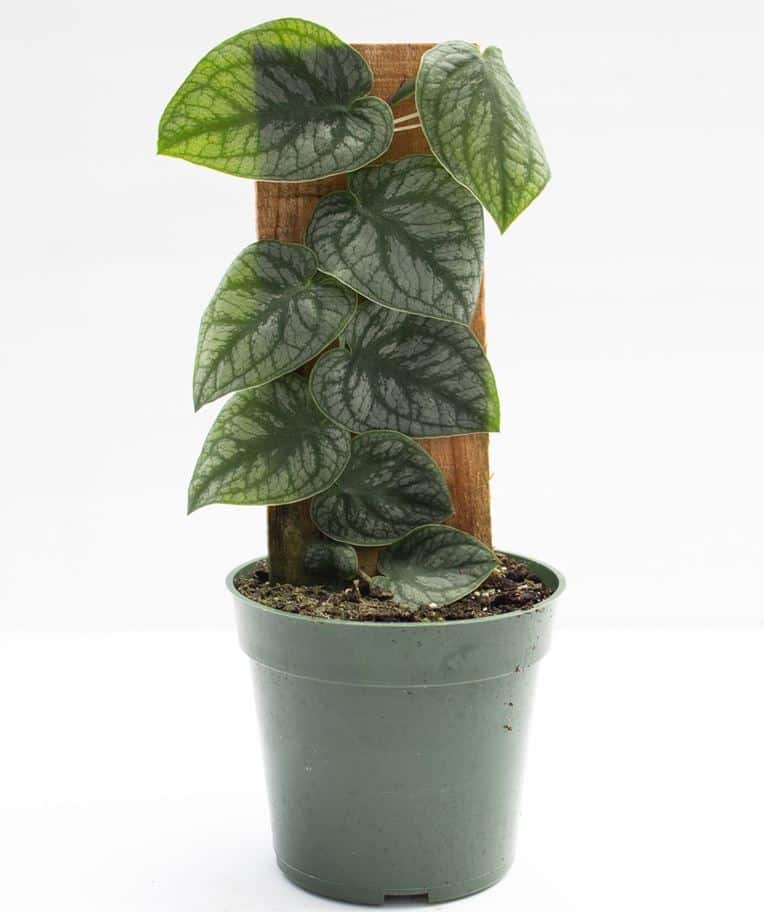
5. Monstera obliqua
The rarest and most expensive non-variegated species is Monstera obliqua or window-leaf Monstera. You will find various forms such as M. obliqua Suriname, Peru, Panama, Tena, Amazonas, and Bolivia. But the Peru form, which has numerous holes, is the most coveted,
Depending on the form, this complex species may have dark, deep green, emerald to light green membranous leaves with varied shapes, with some having oblique, truncate, ovate, or falcate leaf bases
Juvenile leaves are entire, oval to lance-shaped and mature ones will be broadly oval to narrow lance-shaped with no, few, or many holes. But their margin remains entire.
M. obliqua differs from M. adansonii since it has smaller, paper-thin leaves with wavy edges (especially Peru) and has stolons or runners. Also, the holes may run from close margin to near midrib. It grows slowly and costs a lot more, and some forms like Peru hardly go beyond 4 feet.
To know how rare this plant is, Jakes, keepyourplantson_la (Instagram) auctioned his M. obliqua for $23,000. You will pay $500 for a plant with a few leaves and over $1000 or more for an established plant to buy this plant. But if you want to make a saving, go for a stem cutting for stolons if you get a trusted vendor.
We have to warn you. What most people are selling isn’t a Monstera obliqua is probably not the actual plant. Only buy from trusted vendors or rare plant collectors. Try eBay, Etsy.com, Instagram, or Facebook plant groups to get it.
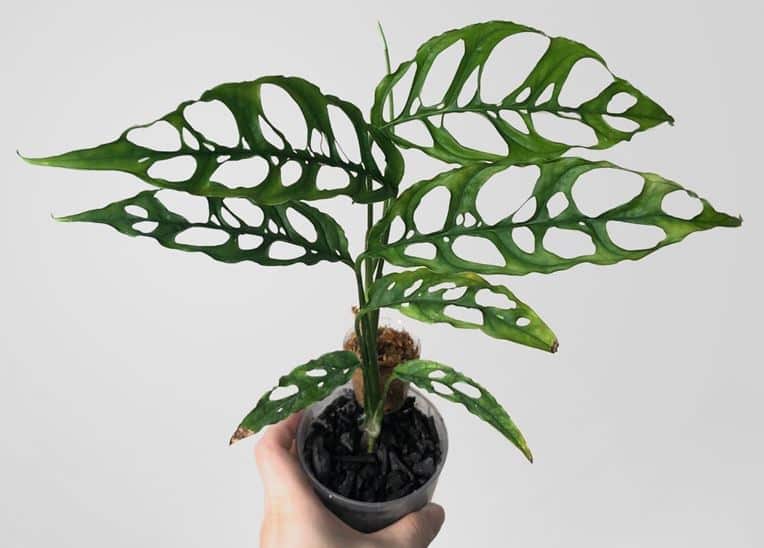
6. Monstera Peru (Monstera karstenianum)
Monstera Peru or Monstera karstenianum is an adorable houseplant with oval to elongated bullate deep green leaves with medium/light green variegations. Costa Farms sells it as Green Galaxy Monstera, and it has other names like Philodendron Karstenianum or Epipremnum Marble Planet.
This plant that has not yet been officially accepted as a Monstera species has the same mature and juvenile-looking plant, i.e., leaves don’t split, fenestrate, or become significantly large.
A stem cutting will cost about $10, while a rooted plant about $20 to $40. But the exact amount you pay depends on where you buy, plant size, and other market forces.
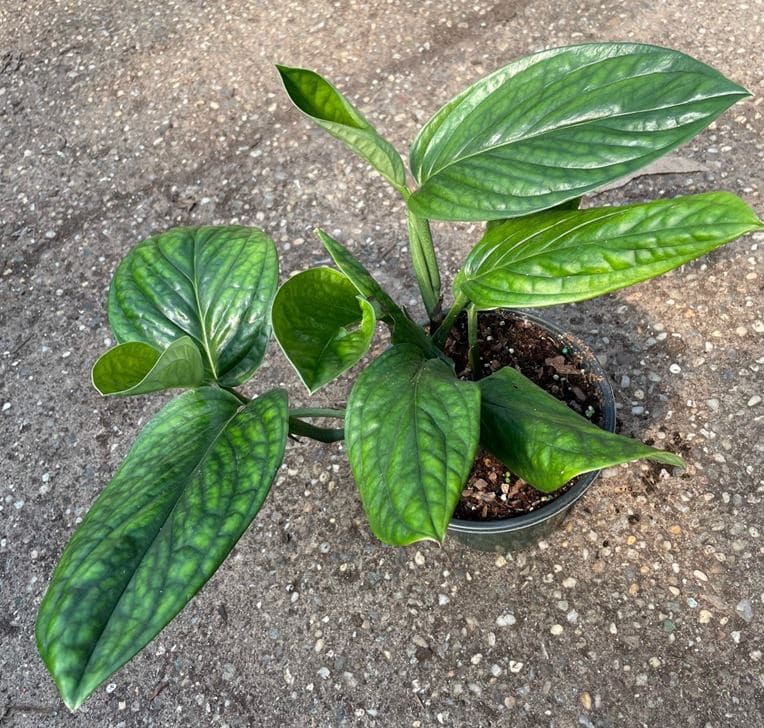
If you want something more colorful, you can go for variegated Monstera Peru. It has lovely yellow variegations – streaks, marbling, sectors with some plants having half-moon leaves.
Since it’s rare, this variegated M. Karstenianum will cost you anything between $150 to $800.

7. Monstera lechleriana
Create that perfect tropical backdrop in your home with Monstera lechleriana. The glossy green oval to lance-shaped leaves borne on a tight head will look amazing. And as the plant grows, it will start having elliptic holes set close to the midrib, and the leaves will be grander.
M. lechleriana goes for only $10 to $40. But it isn’t readily available unless you are willing to buy it online.

If you want to add more vibe to your home, you can go for the rare Monstera Lechleriana albo variegata, which will cost you between $500-$1500. But the non-variegated one goes for only $10 to $40.
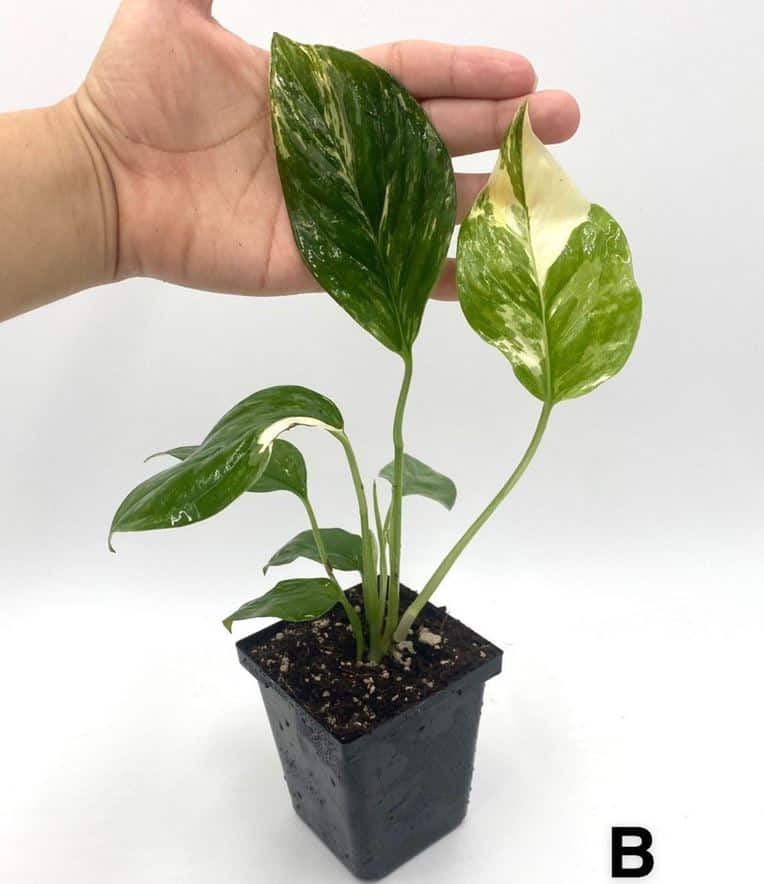
8. Monstera pinnatipartita
Monstera pinnatipartita is a popular houseplant with slightly bullate, oval to elliptical green leaves with light green variegation. It resembles M. Peru except that it is not dark green.
Mature plants will have huge split or pinnatifid dark green leaves (they lose their bicolored appearance) and resemble M. spruceana. These leaves don’t have holes but may rarely have a few.
If you want this gorgeous plant, it’s not hard to find. It will cost you between $30 and $100 for a plant to buy one.
M. pinnatipartita:
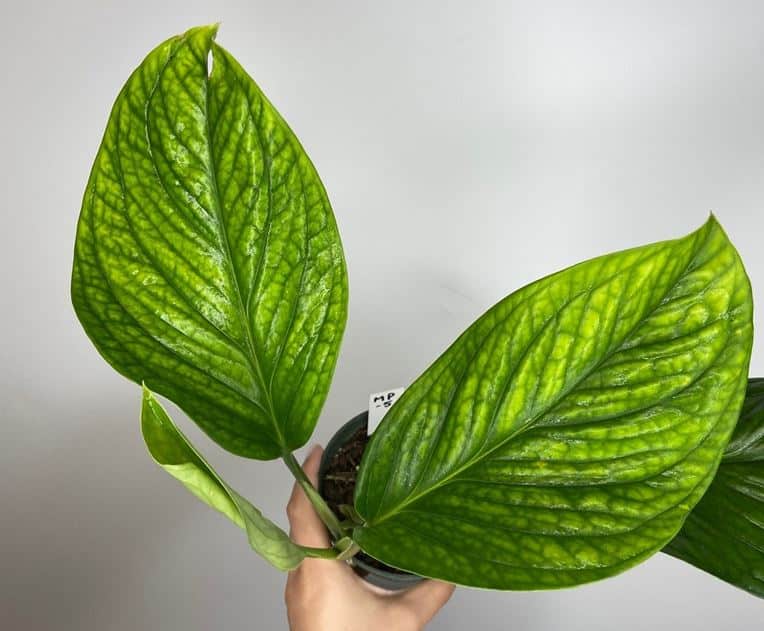
9. Monstera acuminata
In its juvenile stage, Monstera acuminata shingles. It has erected pendent green leaves with short petiole and short internodes. These leaves lie flat on the surface and slightly overlap.
As it grows to maturity, it ceases shingling. Instead, the larger, pendent, perforated dark green leaves with an entire margin will have an erect petiole. Should it reach the top of the surface it’s climbing, it will send down leafless stolons or runners, i.e., with cataphylls only.
Many people often confuse M. acuminata with M. adansonii. But M. adansonii doesn’t shingle or drop stolons, and the leaf surface isn’t smooth. Also, it will have larger glossy green leaves with fewer holes, and the leaves are a bit thinner and elongated.
Most people have the mature M. acuminata form or a clone. We haven’t seen anyone with the shingling type. Its price is between $20 and $35, and not many people have it
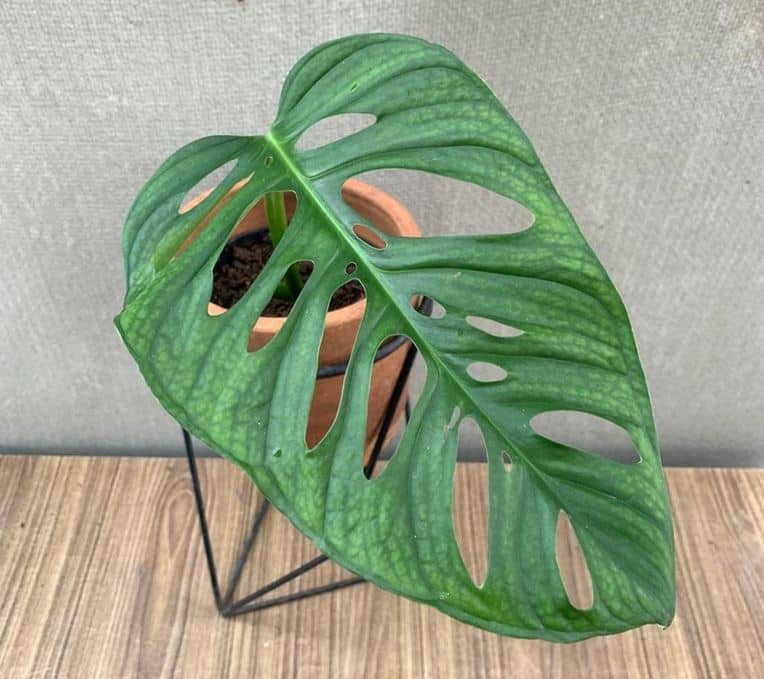
10. Monstera subpinnata
Monstera subpinnata juvenile form is unknown, or the plant doesn’t change much apart from the pinnatifid leaves becoming larger.
It has charming, palm or finger-like green leaves with 3 to 12 pinnae on either side that narrow towards the midrib or base, making it easy to distinguish it from the mature form of M. dissecta.
A cutting will cost you as little as $25, but if you need a more established M. subpinnata, you may spend up to $100 or more.
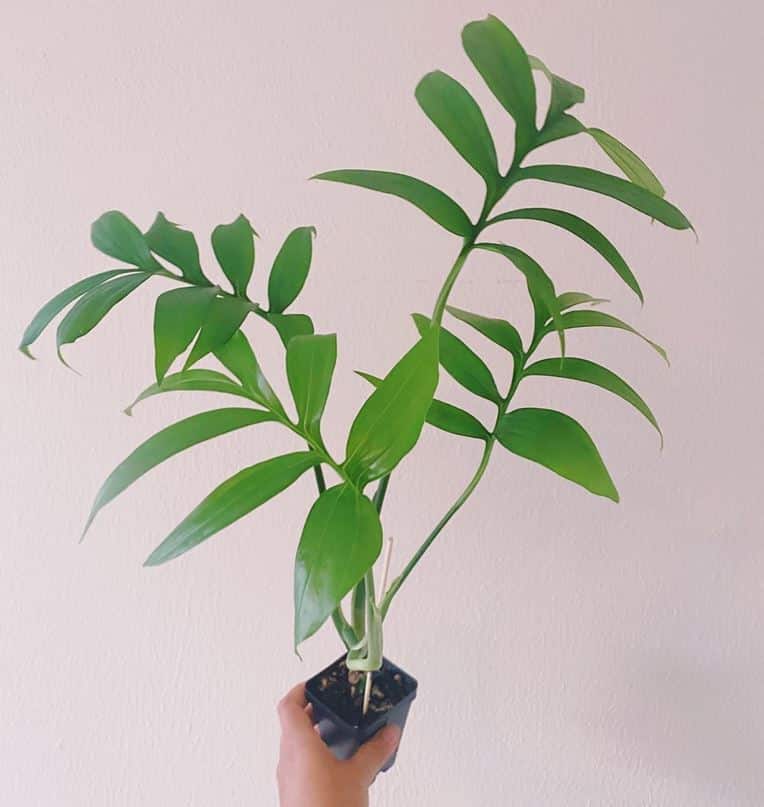
11. Monstera acacoyaguensis
Monstera acacoyaguensis has entire, oval, erect glossy green juvenile leaves that become large and perforated when it matures. Margins remain entire, but it will have 1-2 series of oval to elliptical holes.
It bears some resemblance with M. lechleriana, but the holes are larger. Also, the perforations come series, and the leaves don’t form a tight head cluster. Also, they look like those of M. acuminata, save for their larger size.
If you want to buy M. acacoyaguensis, it will cost you between $20 and $40. But it is not readily available. You are unlikely to get it at local nurseries. Even big-box stores don’t have it.
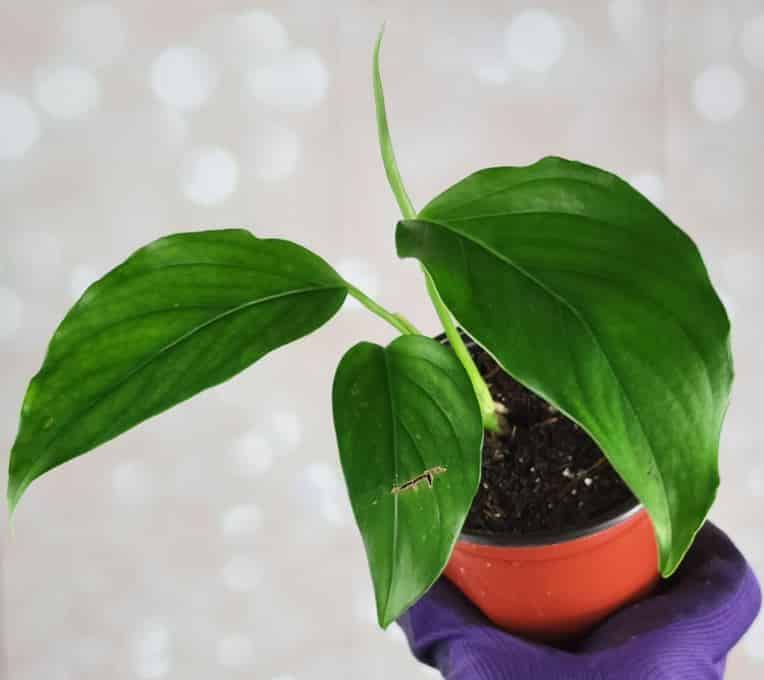
12. Monstera epipremnoides
Monstera epipremnoides is another great-looking species you should include in your collection, especially the Esquelato clone.
Its juvenile form has entire oblong to elliptical glossy green leaves with a heart-shaped base.
On the other hand, a mature plant will have pinnatifid (split) and fenestrated (perforated) leaves, with each side having between 12-20 pinnae. These leaves resemble M. dissecta, except for the more pinnae and elliptical holes along the midrib.
What you commonly find in the market that resembles M. adansonii var. laniata is a clone, known as Monstera epipremnoides ‘Esqueleto” or Monstera Esquelato. This clone has an entire margin and has many holes, some running from almost the margin to the midrib.
Last but not least, M. Esqueleto will cost you between $60 and $200, depending on the size. Most people sell it for between $90 and $160,

13. Monstera Spruceana
Monstera spruceana is a complex species with juvenile plants that may shingle or not. Also, these plants will show variations in leaf shape and coloration.
Juvenile leaves will be almost round to elongated with dark green to gray too plain green. Those that are dark green may have paler markings.
On the other hand, the mature plant will have larger oval to oblong dull green leaves. These leaves are pinnatifid or split, with the pinnae running almost to the midrib. Also, they will not shingle, i.e., they are erect or may hang.
Last but not least, Monstera spruceana will cost you between $40 and $100. But larger established plants will cost more.
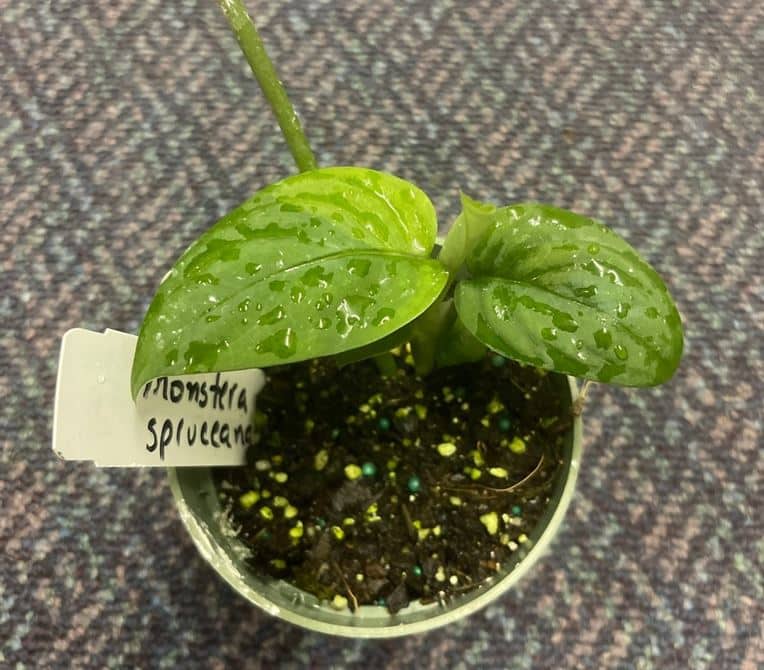
14. Monstera dissecta
You will easily recognize Monstera dissecta by its exserted oval to lance-shaped glossy green juvenile leaves that may be uneven. Mature leaves are pinnatifid or split and form a tight head.
If you are looking for this plant, it is not readily available. So, you expect to pay slightly more with a plant going for between $100 and $600.

Monstera plant care
| USDA hardiness zone | 10b to 12 |
| Humidity | 50% or more. If you have a variegated form, try keeping humidity a bit higher. A 60% will be OK. You can mist your plants, have a humidifier, pebble tray, etc. if you have low humidity |
| Temperature | 65 to 85 degrees Fahrenheit (18 to 29°C). Avoid cold drafts, sudden temperature changes, or heat stress. |
| Light needs | Bright indirect light. Avoid direct sunlight or too little light. |
| Best soil | Slightly acidic to neutral, pH 5.5 to 7, airy, well-drained soil high in organic matter. |
| Watering | Water when the top 2-3 inches of the soil is dry. Don’t follow a watering schedule. |
| Feeding | Feed monthly with an all-purpose, balanced liquid houseplant fertilizer in growing months only. See best fertilizers for Monstera. |
| Pruning and grooming | Cut dead, diseased, or damaged leaves with sterilized pruning scissors. To control size, growth, and shape, cut back a few branches in early spring. Don’t forget to clean or dust leaves. |
| Repotting | Repot growing plants yearly or if rootbound. If they reach the size you need, repot after 2-3 years or rootbound. |
| Support or staking | Provide your plants with a moss pole or trellis for climbing. But this isn’t a must. |
Monstera plant pests, diseases, and common issues
Besides care, there are the common issues your Monstera plant may have, including diseases and pests.
| Pests | Not common if indoors, but your plant may have spider mites, scale insects, whiteflies, thrips, or mealybugs. Use neem oil like Bonide Ready to Use Neem Oil, insecticidal soaps or horticultural oils. |
| Diseases | The primary disease that affects these plants is root rot if you overwater them. But they can have fungal or bacterial leaf spots, rusts, or blights. |
| Yellowing of leaves | The most common cause is overwatering e followed by too little light. Others are too much light, underwatering, and heat stress. |
| Brown spots, tips, edges, or leaves | Low humidity, underwatering, too much light or heat are the most common causes if you see brown edges and tips. For spots, it may be pests or diseases and splotches overwatering. Also, if you recently transplanted your plant, it could be why. |
| Leaves turning black | Start by checking for any signs of pests and disease. If not, it may be overwatering or frost damage. |
| Leaves drooping | Moisture issues include underwatering or low humidity, too much sunlight, or heat stress. |
| Monstera leaves curling | Your plant is thirsty, has low humidity, or has too much light and heat. |
FAQs
The most expensive Monstera is the mint/white Monstera, a truly rare germ that goes for $25,000. It looks adorable.

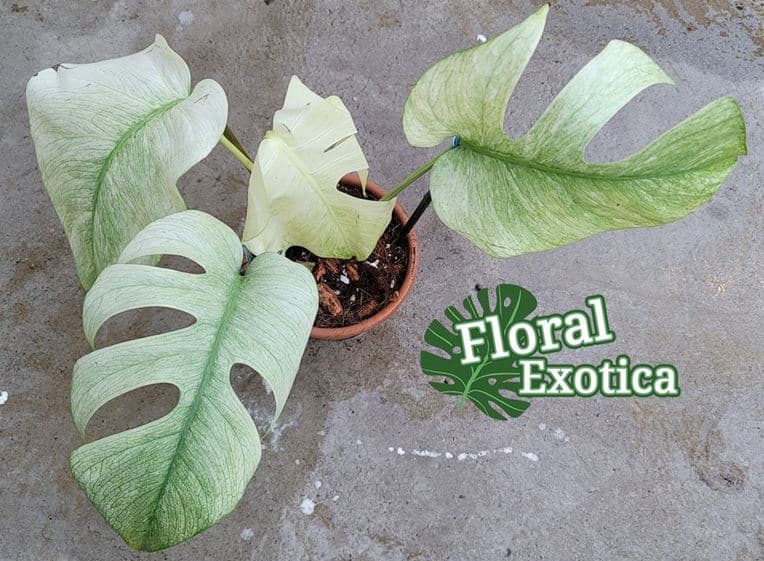




Leave a Reply